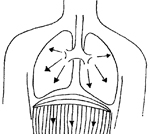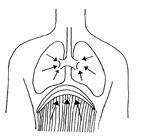| |
|
|
 |
 |
 |
| |
| Breath of Life |
From the time you were born, you have been breathing. Day in and day out, your breath has been regulating your oxygen and carbon dioxide, and has cared for your total physical, mental, and emotional health and well-being. Deep, full breathing cleansed your blood and assisted in your speedy healing, both emotional and physical. It also activated your pituitary gland which stimulated your entire endocrine functions, improving all bodily functions.
A deep, relaxed breath leads to a relaxed mind, more vitality, and an increased feeling of internal security. Using specific breath patterns, you can adjust your emotional and mental state, which is crucial to handle stress in daily life, Kundalini Yoga offers a large range of breathing exercises, or pranayam.
“What is my spirit? My spirit is my spirit; it must flow through me. It is my strength. It must hold me through thick and thin. From where does my strength come? Not from my muscles. Do not misunderstand. Some people are very skinny and very strong. Some are very fat and they are just like a guava. Strength of spirit, strength of the soul, does not come from the body.
The nervous system is attached to the cosmic system attached to cosmic through the astral body. You extend nine feet beyond your physical body, nine feet each side of yourself. So your soul is totally attached to being a woman.
~Yogi Bhajan, Women’s Camp 1977
Breathing exercises
- Simple, Natural Breathing
Watch infants, children, and relaxed energetic adults, breathe naturally. They maintain a high level of activity and adventure throughout the day. As you practice this breath, inhale and exhale through both nostrils, keeping your chest and ribs very relaxed
  Inhale: Inhale slowly into your belly, allowing your abdominal muscles to expand and relax out. A vacuum in your lungs is created, forcing more air automatically into your lungs. Inhale: Inhale slowly into your belly, allowing your abdominal muscles to expand and relax out. A vacuum in your lungs is created, forcing more air automatically into your lungs.
Exhale: Begin the exhale by smoothly bringing your belly in and up, which will raise up your diaphragm and empty your lungs. Your ribs will narrow and your shoulders and chest will lower.
- Long Deep Breathing: A yogic breath
Yogic Long Deep Breathing (LDB) uses the full capacity of your lungs, accelerating the effects of Simple, Natural Breathing. LBD has a multitude of benefits for the maintaining and building your health; LBD energizes as well as calms, relaxes, and speeds up emotional and physical healing.
As you practice Long Deep Breathing, inhale, and exhale slowly through both nostrils Keep your chest and ribs very relaxed, allowing your ribcage to move. Breathe rhythmically: Allow 7 seconds for a complete inhalation. Hold, for a short pause. Allow 7 seconds for a complete exhalation. Hold, for a short pause.
Inhale: Breathe a slow deep breath into your belly as you:
- Allow your abdomen to relax and expand, and your diaphragm descend
- Breathe to expand your chest
- Let your shoulders and collarbone move as your lungs fill
Exhale: Release the breath, beginning the exhale as you:
- Relax your shoulders and upper chest
- Slowly empty your chest, with the assistance of your diaphragm rising up and under your ribs
- Pull in your abdomen to release the last air.
Back to Kundalini Yoga >
|
|
|
 |
 |
 |
|
|
|
|
 |